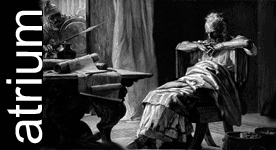The incipit of Peter Jones' Ancient and Modern column:
... the remainder is available (with earlier columns) at the Friends of Classics site.
The principles behind ‘synthetic phonics’, the latest educational reading nostrum, have been around for thousands of years. Heaps of papyrus exercises, exercise-books (and a primary school text-book) have been found, dating from the Greek world of the 5thC BC.
The first thing to be learned was the Greek alphabet, by means of a metrical, chanted song: est’ alpha, beta, gamma, delta, t’ ei te kai / zêt’, êta, thêt’, iota, kappa, lambda, mu etc. Useful hint for teachers: King Herod had a dim son who could not remember the names of the letters, so had 24 slaves of the same age brought up with him, each named after a letter. Then came syllables, each learned in full, and in order: ba, be, bê, bi, bo, bu, bô; ga, ge, gê etc; and they were spoken before they were pronounced (‘bêta alpa ba’). Then came words: first monosyllables, then disyllables and so on, printed e.g. O:dus:seus, Le:on:to:me:nês, including tricky words to test pronunciation, like knaxzbrikh (apparently an illness). There is a ‘quick brown fox’ equivalent (and even more meaningless): bedu zaps khthôm plêktron sphinx, each letter used only once. ...
... the remainder is available (with earlier columns) at the Friends of Classics site.
